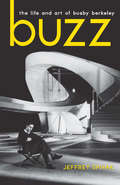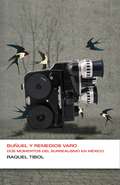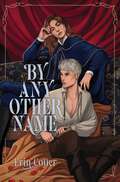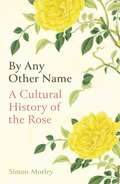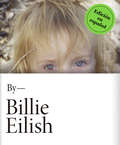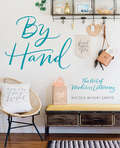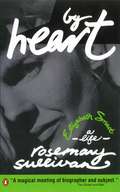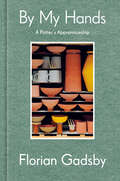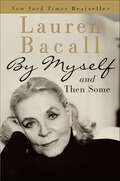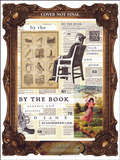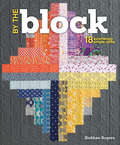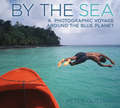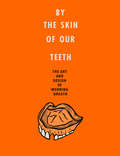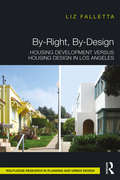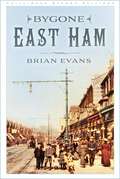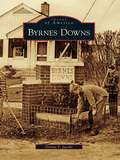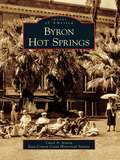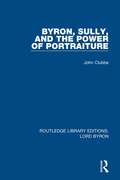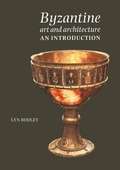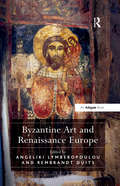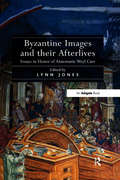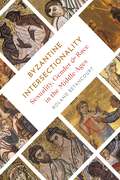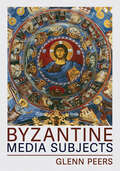- Table View
- List View
Buzz: The Life and Art of Busby Berkeley (Screen Classics)
by Jeffrey SpivakA biography of the director and choreographer who kept America entertained through the Great Depression: &“[A] fascinating read.&” —Playbill Characterized by grandiose song-and-dance numbers featuring ornate geometric patterns and mimicked in many modern films, Busby Berkeley&’s unique artistry is as recognizable and striking as ever. From his years on Broadway to the director&’s chair, Berkeley is notorious for his inventiveness and signature style. Through sensational films like 42nd Street, Gold Diggers of 1933, Footlight Parade, and Dames, Berkeley sought to distract audiences from the troubles of the Great Depression. But while his bold technique is familiar to millions of moviegoers, Berkeley&’s life remains a mystery. Buzz: The Life and Art of Busby Berkeley is a telling portrait of the filmmaker who revolutionized the musical and changed the world of choreography. Berkeley pioneered many conventions still in use today, including the famous &“parade of faces&” technique, which lends an identity to each anonymous performer in a close-up. Carefully arranging dancers in complex and beautiful formations, Berkeley captured perspectives never seen before. Jeffrey Spivak&’s meticulous research magnifies the career and personal life of this beloved filmmaker. Employing personal letters, interviews, studio memoranda, and Berkeley&’s private memoirs, Spivak unveils the colorful life of one of cinema&’s greatest artists.
Buñuel y Remedios Varo: Dos momentos del surrealismo en México
by Varios autoresDos excepcionales entrevistas de Raquel Tibol a referentes internacionales del surrealismo que tuvo lugar en México: Remedios Varo y Luis Buñuel. La autora, una de las más importantes periodistas culturales que ha dado el país, da cátedra en estos textos sobre el arte de la conversación. Hace 61 años Raquel Tibol realizó una entrevista a Luis Buñuel como uno de sus primeros trabajos en nuestro país, publicada el 29 de noviembre de 1953 en México en la Cultura, suplemento del periódico Novedades. De acuerdo con el anecdotario, para hacerla lo abordó en los estudios cinematográficos donde filmaba La ilusión viaja en tranvía, y la conversación, -"cálida y sincera", se lee- tuvo lugar en la que fue la casa del cineasta en México. En definitiva, este libro recoge dos de las voces más claramente identificadas como parte del surrealismo, corriente artística de la Benjamin Péret dijo: "En nuestro tiempo se necesita un lenguaje nuevo y una manera de ver e interpretar al hombre y al mundo muy diferente de la que está en uso. ¿Cómo se podría dar una imagen o un trasunto de la vida actual, si no es por medio del surealismo? Guerras, revoluciones, angustia sin fin: los prodigios de la técnica empleados para aniquilar a los pueblos y desatar por todas partes el caos y la destrucción. Un enorme cambio se está produciendo. Una honda y enorme revolución camina hacia su meta en todos los continentes. El parto del futuro es siempre doloroso, pero nunca lo ha sido tanto como ahora. Un mundo se hunde envuelto en sus propias contradicciones."
By Any Other Name
by Erin Cotter&“A high-stakes, high-drama mystery…led by a plucky, determined hero I would have followed anywhere…[A] romantic, delightful romp!&” —Mackenzi Lee, New York Times bestselling author of A Gentleman&’s Guide to Vice and Virtue A down-on-his-luck actor and an English lord reluctantly team up to solve the murder of Christopher Marlowe in this Shakespearean-era &“quippy, heart-wrenching debut…ideal for fans of Mackenzi Lee and F.T. Lukens&” (Kirkus Reviews).London, 1593. Sixteen-year-old Will Hughes is busy working on Shakespeare&’s stage, stuffing his corsets with straw and pretending to be someone else. Offstage, he&’s playing a part, too. The son of traitors, Will is desperate to keep his identity secret—or risk being killed in the bloody queen&’s imperial schemes. All he wants is to lay low until he earns enough coin to return to his family. But when his mentor, the famous playwright Christopher Marlowe, is murdered under mysterious circumstances, Will&’s plans are hopelessly dashed. What&’s worse, Marlowe was a spy for the queen, tasked with stalking a killer rumored to be part of an elusive order of assassins, and his secrets and untimely death have put Will under a harsh spotlight. Then, when Will unwittingly foils an attempt on the queen&’s life, she names him her next spymaster. Now, to avoid uncomfortable questions, prison, or an even more terrible fate, Will reluctantly starts his new career, which—yes—will secure him the resources to help his family…but at what cost? Adding insult to injury is the young Lord James Bloomsbury, Will&’s new comrade in arms, whose entitled demeanor and unfairly handsome looks get under Will&’s skin immediately. Together, the two hunt the cunning assassin, defend the queen&’s life, and pray to keep their own...all while an unexpected connection blossoms between them.
By Any Other Name: A Cultural History of the Rose
by Simon Morley&‘Fascinating...I&’ll never look at a rose in quite the same way again.&’ Adrian Tinniswood The rose is bursting with meaning. Over the centuries it has come to represent love and sensuality, deceit, death and the mystical unknown. Today the rose enjoys unrivalled popularity across the globe, ever present at life&’s seminal moments. Grown in the Middle East two thousand years ago for its pleasing scent and medicinal properties, it has become one of the most adored flowers across cultures, no longer selected by nature, but by us. The rose is well-versed at enchanting human hearts. From Shakespeare&’s sonnets to Bulgaria&’s Rose Valley to the thriving rose trade in Africa and the Far East, via museums, high fashion, Victorian England and Belle Epoque France, we meet an astonishing array of species and hybrids of remarkably different provenance. This is the story of a hardy, thorny flower and how, by beauty and charm, it came to seduce the world.
By Billie Eilish (Por Billie Eilish)
by Billie EilishThank you for caring. –Billie Eilish La legendaria Billie Eilish nos comparte una ventana muy personal de su vida –dentro y fuera del escenario– en este asombroso libro de fotografías. Cada una de las fotos ha sido cuidadosamente seleccionada y acomodada por la propia Billie, capturando sus más significativos momentos. Complementado con una introducción y pies de foto, Billie nos comparte sus pensamientos sobre esta salvaje travesía en la que está hasta ahora.
By Hand: The Art of Modern Lettering
by Nicole Miyuki Santo<p>Learn the beauty and joy of modern lettering with By Hand, a thoughtful collection of projects and lessons to bring unique, handmade designs into your life, home, and gatherings. <p>In a world of screens and social media, people are constantly searching for ways to reconnect to the handmade and the authentic-to add a personal spark and a beautiful look to everyday objects and occasions. The art of modern lettering is a point of connection, a way of crafting letters and words into something that delights the eyes and feeds the soul. With unique projects, a gorgeous exposed spine and lay-flat binding, and an Instagram-worthy aesthetic, By Hand provides an inspirational jumping-off point for readers who want to incorporate lettering into a slower, more intentional lifestyle. <p>Blending the aspirational and the instructional, By Hand brings the beauty of lettering beyond the page, through 30 distinct projects, from watercolor placecards to cozy pillows. Relatable lessons introduce readers to the essentials of lettering, including tools (brush pens, brushes, and paint pens), essential lessons, and developing a personal style, with the warm and welcoming approach of popular Instagram letterer Nicole Miyuki Santo. Encouraging lessons sprinkled throughout the book add a touch of mindfulness, while bright, airy photography and step-by-step lettered samples make this lovely volume a stunning approach to an on-trend pastime.</p>
By Heart: Elizabeth Smart
by Rosemary Sullivan"The price of life is pain, since the price of comfort is damnation." Sensuously beautiful, intensely passionate, generous to a fault — and one of the century's most brilliant writers of poetic prose — Elizabeth Smart carved her own destiny through sheer determination, strength and perserverance. In By Heart, the first biography of Smart, Rosemary Sullivan recounts the author's childhood in Ottawa as the second daughter of an affluent and well-connected family. Inspired by romantic notions of rebellion, Smart rejected what she perceived to be a colonistic literary community and entered a long period of self-imposed exile, desperate to escape family and country, and willing to sacrifice both wealth and propriety in favour of freedom. During her frequent trips to Europe, New York, California and Mexico, Smart came to know many of the important writers of the day, including W.H. Auden, Christopher Isherwood and Lawrence Durrell. While browsing in a London bookstore, she discovered the poetry of George Barker and instantly fell in love with the married poet. They met. Thus began one of the most intense, extraordinary and scandalous love affairs of our time. Their passionate and troubled relationship inspired Smart's By Grand Central Station, I Sat Down and Wept, which critic Brigid Bronphy has called one of the world's half dozen masterpieces of poetic prose. Partly because of the difficulties in single-handedly raising the four children she had with George Barker, and partly because of her own lack of confidence, it would be thirty-two years before Smart published a second novel. By Heart explores the career of a woman writer in the 1940s: the struggle to speak when silence is seductive, the battle against a profound sense of inadequacy, the release and elation that comes out of the pain of writing. The life of Elizabeth Smart is a story of extremes, of life as the supreme fiction. As Smart asks in her final journals, "Can I be contented with my lot? Well, I danced."
By My Hands: A Potter's Apprenticeship (A Memoir)
by Florian GadsbyThe internet&’s favorite potter opens up about his life and craft in this inspiring, stunningly photographed ode to the beauty of small things that brighten life's daily rituals.Florian Gadsby has devoted his life to pottery, refining his technique towards the point of perfection—and as his skill has grown, he has shared his work online, inspiring millions with his meditative videos of gorgeous pottery. Based at a studio in North London, he releases three new collections per year, characterized by simple forms and sharp edges, which sell out in a matter of minutes.In By My Hands, Florian tells the story of his artistic awakening, his education in England, Ireland and Japan, and the sheer discipline which has led him to become the cultural sensation he is today. Arguing for the value in dedicating yourself to a craft, Florian weaves anecdotes about particular pots and processes into the narrative of his life. He explores what he has learned from specific pieces he was taught to create during his apprenticeships—including yunomi, a Japanese teacup, in Mashiko, Japan—and how they have informed his philosophy and approach to his work.By My Hands is a thoughtful, visual celebration of the simple things, such as a hand-thrown mug or bowl, that add meaning to our lives, as well as an inspiring testament to the power of perseverance.
By Myself and Then Some
by Lauren BacallThe epitome of grace, independence, and wit, Lauren Bacall continues to project an audacious spirit and pursue on-screen excellence. The product of an extraordinary mother and a loving extended family, she produced, with Humphrey Bogart, some of the most electric and memorable scenes in movie history. After tragically losing Bogart, she returned to New York and a brilliant career in the theatre. A two-time Tony winner, she married and later divorced her second love, Jason Robards, and never lost sight of the strength that made her a star.Now, thirty years after the publication of her original National Book Award–winning memoir, Bacall has added new material to her inspiring history. In her own frank and beautiful words, one of our most enduring actresses reveals the remarkable true story of a lifetime so rich with incident and achievement that Hollywood itself would be unable to adequately reproduce it.
By Private Invitation: Salon Games Book 1 (Salon Games)
by Stephanie JulianFor fans of Maya Banks, Beth Kery and Jo Davis comes the first sizzlingly romantic and highly erotic installment in Stephanie Julian's Salon Games series.Some invitations don't need to be sent...only accepted. Antiques dealer Annabelle Elder's life is nowhere near as passionate as the erotic art she collects. Intending to explore her desires at a decadent New Year's Eve party, she finds unexpected passion in the arms of Jared Golden... Handsome, rich and charming, Jared has created an anything-goes pleasure palace at the Haven Hotel, catering to every special wish. Seducing Annabelle was easy, yet being seduced in turn was unanticipated... But in exploring their sensual fantasies, Jared and Annabelle are caught in a web of painful secrets and troubled pasts. And to face the truth they must trust in the power of true love...This game is only the beginning... To play more seductive Salon Games, return to the series with No Reservations and Over Exposed.
By The Book
by Diane Mavis SchoemperlenNew from the Winner of the Writers' Trust of Canada Marian Engel Awardand the Governor General's Award for English FictionOnce touted as compendiums of human knowledge, the encyclopedias and handbooks of bygone eras now read quaintly, if not comically-yet within their musty pages are often found phrases of uncanny evocative power. Scrupulously stitching such fragments together, in a sequel to the Governor General's Award-winning Forms of Devotion, By The Book is a collection of verbal and visual collages whose alchemies transform long-dead texts into tales of enduring vitality. With her visually witty full-colour artwork and stories like "What Is A Hat? Where Is Constantinople? Who Was Sir Walter Raleigh? And Many Other Common Questions, Some With Answers, Some Without," and "Consumptives Should Not Kiss Other People: A Handy Guide to the Care and Maintenance of Your Family's Good Health," Schoemperlen's irreverent and ironic brand of nostalgia combines vintage kitsch with comic, creepy, unexpectedly moving yarns.Praise for By The Book"Diane Schoemperlen's By The Book is a bravura performance. Fragments, collage, assemblage, found poetry - none of the conventional words cover it for they miss the fantastic wit, the energy of humour, the divine ability to find comedic ore in the print detritus of our culture. She doesn't rescue texts; with her wicked sense of irony, she actually puts thought where there was none. She infects the banal with the virus of her own brain and makes it into art. Then she makes a picture of it-oh, dwell upon the details; there are whole novels lurking in the details."-Douglas GloverPraise for Diane Schoemperlen"Schoemperlen's inventive language and narrative structures encourage readers to be free 'from the prison of everyday thinking."-New York Times Book Review"Lovely, clever [and] imaginative."-Wall Street Journal"Cuttingly witty ... Schoemperlen could almost form a school of piquant and inventive fiction with Julie Hecht, Janet Kauffman, and Lydia Davis."-Booklist"There is no mistaking a Schoemperlen story-devoted to form, faithful to the mysteries of the everyday."-The Globe & Mail
By the Block: 18 Surprisingly Simple Quilts
by Siobhan RogersSimple, sophisticated quilts sewn "by the block." Today's quilters have many demands on their time but still want to create beautiful quilts. By the Block shows the time-poor quilter how to make sophisticated, complex-looking quilts that are based on easy-to-assemble quilt blocks. The 18 quilts in the book feature modern fabric choices and clever design, but all use standard quilting techniques that are in virtually every quilter's skill set. Author Siobhan Rogers has designed quilts ranging from crib- to king-size for beds as well as several large projects suitable for hanging. Four of the quilts have colorway variations that show the versatility of the basic design. The book is organized according to technique such as log cabins, half-square triangles, or curved piecing, but each project offers a new twist on the traditional methods of piecing and constructing quilts. Some of the quilt blocks are oversized, which help the quilter work efficiently, and the author offers additional timesaving tips.
By the Sea
by Peter GuttmanRenowned travel photographer Peter Guttman takes readers on an unforgettable journey across the high seas, exploring oceanic cultures, marine life, coastal landscapes, and nautical pastimes that will capture the imagination of every beach lover, sailor, surfer, and traveler. Explore hundreds of sights and wonders such as: Enchanting harbor illuminations in Massachusetts Viking settlements in Newfoundland Vibrant Cajun festivals in the Louisiana bayous Secluded Caribbean hideaways Colorful floating villages in Southeast Asia Bright turquoise waters in Zanzibar Hot springs and lighthouses of the Oregon coast By the Sea is a vast and dazzling survey of the aquatic enchantments our planet has to offer, and it’s sure to inspire and excite. A true photographic testament to the drama, majesty, and beauty of the diverse maritime world, this visual treasury is perfect for anyone with a love of salt air. Bon voyage!
By the Skin of Our Teeth: The Art and Design of Morning Breath
by Jason Noto Doug CunninghamA lush, full-color, beautifully designed visual history that brings to life the innovative and creative world of Morning Breath Co. Inc., the Brooklyn-based boutique design studio whose collaborators including top musical artists (from Jay Z to the Foo Fighters) as well as such top brands as Vans and Adidas. In 1996 while working at the in-house design department at Think Skateboards in San Francisco, creatives Doug Cunningham and Jason Noto forged a collaborative style that would transform into a remarkable partnership: an endeavor they called Morning Breath.Working with some of the top music artists and corporations, Morning Breath Co. Inc. has made its aesthetic mark on pop culture, devising Grammy-nominated and award-winning work that has been featured in art shows across the country. Incorporating passé pop culture art elements into fresh, original imagery, this go-to design team for the Foo Fighters has produced an amazing portfolio of artwork for a wide range of clients, including Absolut Vodka, Solomon Snowboards, MTV, Pepsi, Kanye West, Eminem, Jay Z , Slayer, Queens of the Stone Age, Vans, and Adidas.In By the Skin of Our Teeth: The Art and Design of Morning Breath, Cunningham and Noto tell the story of Morning Breath in this collection showcasing their artwork and designs, from music packaging, T-shirts, and posters to fine arts, lifestyle, and products. They also spotlight the artistic influences and roots that have shaped them, including graffiti art, silk screening, computer graphics, collaging, painting, and fine arts.Filled with dozens of full-color images, By the Skin of Our Teeth is an invaluable display of Morning Breath’s provocative, imaginative, and original style—a combination of the dream-like and the quotidian—that has captured the attention of artists, designers, and pop culture lovers everywhere.The list of contributors consists of a wide-range of writers and artists, all of whom help put the creative work of Morning Breath in narrative perspective. Contributors include Bill Adler, Jeremy Fish, Geoff Peveto, Evan Pricco, and Eddie Zammit.
By-Right, By-Design: Housing Development versus Housing Design in Los Angeles
by Liz FallettaHousing is an essential, but complex, product, so complex that professionals involved in its production, namely, architects, real estate developers and urban planners, have difficulty agreeing on “good” housing outcomes. Less-than-optimal solutions that have resulted from a too narrow focus on one discipline over others are familiar: high design that is costly to build that makes little contribution to the public realm, highly profitable but seemingly identical “cookie-cutter” dwellings with no sense of place and well-planned neighborhoods full of generically designed, unmarketable product types. Differing roles, languages and criteria for success shape these perspectives, which, in turn, influence attitudes about housing regulation. Real estate developers, for example, prefer projects that can be built “as-of-right” or “by-right,” meaning that they can be approved quickly because they meet all current planning, zoning and building code requirements. Design-focused projects, heretofore “by-design,” by contrast, often require time to challenge existing regulatory codes, pursuing discretionary modifications meant to maximize design innovation and development potential. Meanwhile, urban planners work to establish and mediate the threshold between by-right and by-design processes by setting housing standards and determining appropriate housing policy. But just what is the right line between “by-right” and “by-design”? By-Right, By-Design provides a historical perspective, conceptual frameworks and practical strategies that cross and connect the diverse professions involved in housing production. The heart of the book is a set of six cross-disciplinary comparative case studies, each examining a significant Los Angeles housing design precedent approved by-variance and its associated development type approved as of right. Each comparison tells a different story about the often-hidden relationships among the three primary disciplines shaping the built environment, some of which uphold, and others of which transgress, conventional disciplinary stereotypes.
Bygone East Ham
by Brian EvansEast Ham was sparsely inhabited in the fourteenth century and had not changed much with the advent of the railway in the 1850s. Farmers and market gardeners grew crops for the ‘distant’ London market, their houses scattered thinly from Wanstead flats in the north to just south of the turnpike road.A phenomenal transformation came in the second half of the nineteenth century as the demands of Britain’s growing industries and population led to the use of land for factories and, eventually, to a house-building boom. Fortunately, photos of these amazingly rapid changes have survived to add great impact to this narrative of East Ham’s past.Brian Evans captures the rise of East Ham from an area of fields and marshes to a county borough by 1914. Bygone East Ham will fascinate all who know the place whilst adding greatly to our understanding of the making of the present district.
Byrnes Downs
by Donna F. JacobsLocated in the West Ashley area of Charleston, Byrnes Downs is a charming community designed and developed by the V-Housing Corporation in the 1940s. The Long Construction Company built this successful war-housing project of 360 houses that became the lifelong homes for many families. Early settlers who had made homes on the Charleston peninsula traveled west to develop the suburban neighborhoods of St. Andrew's Parish: Byrnes Downs, Albemarle Point, the Crescent, Moreland, Old Windermere, South Windermere, Wappoo Heights, and Westwood.
Byron Hot Springs
by East Contra Costa Historical Society Carol A. JensenByron Hot Springs is sometimes called the "Carlsbad of the West," after the famed European health spas. The resort hosted the famous, the wealthy, the infirm, and the curious alike during the early 20th century. The 160-acre property, in eastern Contra Costa County near the San Joaquin River, featured three grand hotels designed by renowned San Francisco architect James Reid. Amidst this stylish backdrop were prominent guests in 19th-century finery, early Hollywood royalty, Prohibition entertainments, mineral water "cures" for various ailments, and secret interrogations of World War II POWs (when it was known as "Camp Tracy"). Aside from the hot springs themselves, the resort boasts one of the oldest golf courses in the western United States.
Byron, Sully, and the Power of Portraiture (Routledge Library Editions: Lord Byron #3)
by John ClubbeFirst published in 2005. Since the early nineteenth century, Byron, the man and his image, have captured the hearts and minds of untold legions of people of all political and social stripes in Britain, Europe, America, and around the world. This book focuses on the history and cultural significance for Federal America of the only portrait of Byron known to have been painted by a major artist. In private hands from 1826 until this day, Thomas Sulley’s Byron has never before been the subject of scholarly study. Beginning with the discovery of the portrait in 1999 and a 200-year narrative of the portrait’s provenance and its relation to other well-known Byron portraits, the author discusses the work within the broad context of British and American portraiture of the late eighteenth and early nineteenth centuries.
Byzantine Art and Architecture: An Introduction
by Lyn RodleyThe Byzantine empire began with the transformation of the Roman empire initiated by the official acceptance of Christianity and the establishment of Constantinople as the capital city. It ended with the fall of that city to the Ottoman Turks in 1453. The art and architecture of the empire reflects its changing fortunes, the development of Christianity, and the cultural influences that affected it. This book offers a systematic introduction to the material culture of the Byzantine empire, from the fourth to the fourteenth centuries. It provides for the student or any other interested reader a compendium of material which is generally difficult to access: much of the writing on Byzantine art and architecture is not in English, and is published as articles in scholarly journals. The book sets out the subject in an accessible manner, describing and discussing by period the surviving material - and that which can be reconstructed from documentary sources - and exploring its social/historical context. The text is copiously illustrated by well over 400 halftones, plans and maps.
Byzantine Art and Diplomacy in an Age of Decline
by Cecily J. HilsdaleThe Late Byzantine period (1261-1453) is marked by a paradoxical discrepancy between economic weakness and cultural strength. The apparent enigma can be resolved by recognizing that later Byzantine diplomatic strategies, despite or because of diminishing political advantage, relied on an increasingly desirable cultural and artistic heritage. This book reassesses the role of the visual arts in this era by examining the imperial image and the gift as reconceived in the final two centuries of the Byzantine Empire. In particular it traces a series of luxury objects created specifically for diplomatic exchange with such courts as Genoa, Paris and Moscow alongside key examples of imperial imagery and ritual. By questioning how political decline refigured the visual culture of empire, Dr Hilsdale offers a more nuanced and dynamic account of medieval cultural exchange that considers the temporal dimensions of power and the changing fates of empires.
Byzantine Art and Renaissance Europe
by Angeliki Lymberopoulou Rembrandt DuitsByzantine Art and Renaissance Europe discusses the cultural and artistic interaction between the Byzantine east and western Europe, from the sack of Constantinople by the Fourth Crusade in 1204 to the flourishing of post-Byzantine artistic workshops on Venetian Crete during the fifteenth and sixteenth centuries and the formation of icon collections in Renaissance Italy. The contributors examine the routes by which artistic interaction may have taken place, and explore the reception of Byzantine art in western Europe, analysing why artists and patrons were interested in ideas from the other side of the cultural and religious divide. In the first chapter, Lyn Rodley outlines the development of Byzantine art in the Palaiologan era and its relations with western culture. Hans Bloemsma then re-assesses the influence of Byzantine art on early Italian painting from the point of view of changing demands regarding religious images in Italy. In the first of two chapters on Venetian Crete, Angeliki Lymberopoulou evaluates the impact of the Venetian presence on the production of fresco decorations in regional Byzantine churches on the island. The next chapter, by Diana Newall, continues the exploration of Cretan art manufactured under the Venetians, shifting the focus to the bi-cultural society of the Cretan capital Candia and the rise of the post-Byzantine icon. Kim Woods then addresses the reception of Byzantine icons in western Europe in the late Middle Ages and their role as devotional objects in the Roman Catholic Church. Finally, Rembrandt Duits examines the status of Byzantine icons as collectors’ items in early Renaissance Italy. The inventories of the Medici family and other collectors reveal an appreciation for icons among Italian patrons, which suggests that received notions of Renaissance tastes may be in need of revision. The book thus offers new perspectives and insights and re-positions late and post-Byzantine art in a broader European cultural context.
Byzantine Images and their Afterlives: Essays in Honor of Annemarie Weyl Carr
by Lynn JonesThe twelve papers written for this volume reflect the wide scope of Annemarie Weyl Carr's interests and the equally wide impact of her work. The concepts linking the essays include the examination of form and meaning, the relationship between original and copy, and reception and cultural identity in medieval art and architecture. Carr’s work focuses on the object but considers the audience, looks at the copy for retention or rejection of the original form and meaning, and always seeks to understand the relationship between intent and perception. She examines the elusive nature of ’center’ and ’periphery’, expanding and enriching the discourse of manuscript production, icons and their copies, and the dissemination of style and meaning. Her body of work is impressive in its chronological scope and geographical extent, as is her ability to tie together aspects of patronage, production and influence across the medieval Mediterranean. The volume opens with an overview of Carr’s career at Southern Methodist University, by Bonnie Wheeler. Kathleen Maxwell, Justine Andrews and Pamela Patton contribute chapters in which they examine workshops, subgroups and influences in manuscript production and reception. Diliana Angelova, Lynn Jones and Ida Sinkevic offer explorations of intent and reception, focusing on imperial patronage, relics and reliquaries. Cypriot studies are represented by Michele Bacci and Maria Vassilaki, who examine aspects of form and style in architecture and icons. The final chapters, by Jaroslav Folda, Anthony Cutler, Rossitza Schroeder and Ann Driscoll, are linked by their focus on the nature of copies, and tease out the ways in which meaning is retained or altered, and the role that is played by intent and reception.
Byzantine Intersectionality: Sexuality, Gender, and Race in the Middle Ages
by Roland BetancourtA fascinating history of marginalized identities in the medieval worldWhile the term “intersectionality” was coined in 1989, the existence of marginalized identities extends back over millennia. Byzantine Intersectionality reveals the fascinating, little-examined conversations in medieval thought and visual culture around matters of sexual and reproductive consent, bullying and slut-shaming, homosocial and homoerotic relationships, trans and nonbinary gender identities, and the depiction of racialized minorities. Roland Betancourt explores these issues in the context of the Byzantine Empire, using sources from late antiquity and early Christianity up to the early modern period. Highlighting nuanced and strikingly modern approaches by medieval writers, philosophers, theologians, and doctors, Betancourt offers a new history of gender, sexuality, and race.Betancourt weaves together art, literature, and an impressive array of texts to investigate depictions of sexual consent in images of the Virgin Mary, tactics of sexual shaming in the story of Empress Theodora, narratives of transgender monks, portrayals of same-gender desire in images of the Doubting Thomas, and stereotypes of gender and ethnicity in representations of the Ethiopian Eunuch. He also gathers evidence from medical manuals detailing everything from surgical practices for late terminations of pregnancy to save a mother’s life to a host of procedures used to affirm a person’s gender.Showing how understandings of gender, sexuality, and race have long been enmeshed, Byzantine Intersectionality offers a groundbreaking look at the culture of the medieval world.
Byzantine Media Subjects (Medieval Societies, Religions, and Cultures)
by Glenn A. PeersByzantine Media Subjects invites readers into a world replete with images—icons, frescoes, and mosaics filling places of worship, politics, and community. Glenn Peers asks readers to think themselves into a world where representation reigned and humans followed, and indeed were formed. Interrogating the fundamental role of representation in the making of the Byzantine human, Peers argues that Byzantine culture was (already) posthuman. The Byzantine experience reveals the extent to which media like icons, manuscripts, music, animals, and mirrors fundamentally determine humans. In the Byzantine world, representation as such was deeply persuasive, even coercive; it had the power to affect human relationships, produce conflict, and form self-perception. Media studies has made its subject the modern world, but this book argues for media having made historical subjects. Here, it is shown that media long ago also made Byzantine humans, defining them, molding them, mediating their relationship to time, to nature, to God, and to themselves.
